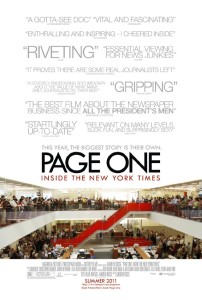The “Old Gray Lady” ain’t what she used to be as revealed in the engaging, scattershot documentary Page One: Inside the New York Times. Director Andrew Rossi and his crew were given greater access to the buzzing offices of the venerable newsroom than any filmmakers have had before. What they emerged with after following a select group of reporters from the Media division throughout 2010 is a portrait of a newspaper coping with the rapidly-advancing world of information delivery and the question of their place in a redefined climate of news-gathering and reportage.
 A quick historical argument for the importance of investigative journalism is proposed by interviews with key players in the publishing of “The Pentagon Papers” in 1971 (first reported on by the Times’ Neil Sheehan) and the diligent footwork of Woodward and Bernstein in uncovering the crimes of Watergate and beyond – revelations brought to light by dogged ground-level journalism that saw the Washington Post duo delving into their story until a great tapestry of corruption unfolded, ending in a U.S. president’s resignation. The romance of the intrepid newspaperman may have reached its apotheosis when Richard Nixon boarded that helicopter. Since then, “yellow” journalism has encroached closer to (or completely taken over) the front pages in spite of the continued vigilance of papers like the New York Times.
A quick historical argument for the importance of investigative journalism is proposed by interviews with key players in the publishing of “The Pentagon Papers” in 1971 (first reported on by the Times’ Neil Sheehan) and the diligent footwork of Woodward and Bernstein in uncovering the crimes of Watergate and beyond – revelations brought to light by dogged ground-level journalism that saw the Washington Post duo delving into their story until a great tapestry of corruption unfolded, ending in a U.S. president’s resignation. The romance of the intrepid newspaperman may have reached its apotheosis when Richard Nixon boarded that helicopter. Since then, “yellow” journalism has encroached closer to (or completely taken over) the front pages in spite of the continued vigilance of papers like the New York Times.
Ad revenue continued to plummet and death notices for century-old daily print-edition papers (Rocky Mountain News, Seattle Post-Intelligencer, etc.) were disconcertingly common in the year Rossi and company followed their subjects, so the question of “could the New York Times actually go out of business?” becomes the central narrative drama and introduces us to the film’s breakout star: Media and Cultural reporter David Carr. A former street junkie, Carr is quite the character – a blend of underground comics legends Harvey Pekar, Robert Crumb, and “poet of the gutter” Charles Bukowski. Raspy-voiced and no-nonsense, Carr is the perfect attack dog to take on smug New Media upstarts (Newser.com, Twitter) on various conference panels and – in a particularly funny scene – the hipster publishers of Vice Magazine and what Carr perceives as their exploitative third-world travelogue series. Page One: Inside the New York Times could have focused entirely on David Carr and I would have been satisfied.
Late in the film, the publishing of classified U.S documents by the rogue “WikiLeaks” group throws down an unprecedented gauntlet to the newspaper’s regulated methods now faced with the internet’s ethical black hole. Being present for this turning point justifies the time Rossi’s crew spent on the project even if the rest of their footage is merely sociological entertainment rather than time capsule document.
 While the film mostly laments the shuttering of newspapers and the tarnished reputation of the New York Times following a couple of in-house scandals – reporter Jayson Blair’s plagiarism and Judith Miller’s hawkish articles leading up to the Iraq War – it takes special glee in the gossipy tale of sexual harassment in the “frat house” environment of the rival Tribune Company. Unkempt and proudly in favor of the tabloid approach practiced at his media empire, Tribune’s CEO Sam Zell is an ideal villain for a movie about newspapers under attack – his disgraced exit in light of a lengthy David Carr expose on elicit shenanigans at the highest ranks of Tribune scores a major victory for serious investigative fieldwork and brings a feeling of closure to an intriguing but brief guided tour of the Times’ hallowed halls. Now go buy a newspaper![box_info]WHERE TO WATCH (powered by JustWatch)
While the film mostly laments the shuttering of newspapers and the tarnished reputation of the New York Times following a couple of in-house scandals – reporter Jayson Blair’s plagiarism and Judith Miller’s hawkish articles leading up to the Iraq War – it takes special glee in the gossipy tale of sexual harassment in the “frat house” environment of the rival Tribune Company. Unkempt and proudly in favor of the tabloid approach practiced at his media empire, Tribune’s CEO Sam Zell is an ideal villain for a movie about newspapers under attack – his disgraced exit in light of a lengthy David Carr expose on elicit shenanigans at the highest ranks of Tribune scores a major victory for serious investigative fieldwork and brings a feeling of closure to an intriguing but brief guided tour of the Times’ hallowed halls. Now go buy a newspaper![box_info]WHERE TO WATCH (powered by JustWatch)
[/box_info]

